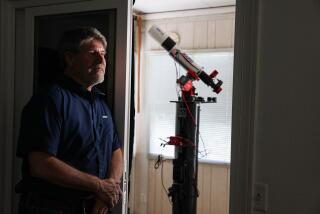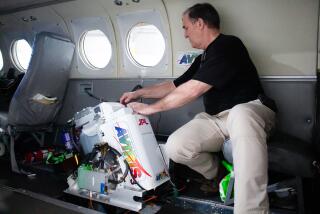COLUMN ONE : A Second Great Leap Into Space : Like Galileo’s pioneering experiments 400 years ago, the launching of an observatory in space should open whole new worlds to the human eye.
- Share via
As the first scientist ever to turn a telescope on the heavens, the Italian mathematician Galileo Galilei saw wonders that no one had seen before.
The moon was not as bland as it had seemed to his predecessors. It had great craters, towering mountains and deep valleys. And there in the distance glowed Jupiter, the giant planet of the solar system. Galileo discovered the first four of Jupiter’s moons.
But the most awesome sight of all lay beyond the solar system. Everywhere he looked, Galileo saw stars. As he ventured across the threshold of discovery, a universe emerged that was far more vast than anyone had imagined. It just seemed to go on forever.
That was nearly four centuries ago. Today, a child with a few dollars can buy an instrument far better than the crude telescope that Galileo used to launch the human race on one of its greatest adventures--the modern exploration of the heavens. Although he did not invent the telescope, as is so often stated in popular accounts, Galileo was the first to use the “spyglass” as an astronomical rather than a nautical instrument. His discoveries revolutionized the way humans felt about themselves. And now, all these years later, the second revolution in astronomy is about to begin.
“Every great civilization attempts to leave a legacy,” said Eric Chaisson, senior scientist at the Space Telescope Science Institute in Baltimore. In astronomy, he continued, there have been two “great leaps forward.”
The first was Galileo in the early 1600s. The second, he added, will be the launching of the Hubble Space Telescope this spring.
Orbiting above the Earth, Space Telescope will lift human eyes above the confining veil of the Earth’s atmosphere to study the universe in ways that it has never been seen before. Like Galileo, the men and women who will use its nearly perfect optics will in many ways see the universe for the first time as they embark on an armchair journey through space that is bound to revolutionize human perceptions of the world in which we live.
Within a few years, many contemporary ideas about the universe will crumble. Not all the questions will be answered, but all the textbooks will have to be rewritten.
Astronomical instruments on the ground are limited to observing the universe only through very narrow “windows” in the electromagnetic spectrum, the most obvious of which is visible light. But many of the most dynamic events in the universe emit radiation outside the visible spectrum, such as X-rays and gamma rays, and those wavelengths are absorbed by the Earth’s atmosphere.
Space Telescope, like other observatories that are to be launched in the years ahead, will in effect lift astronomers above the atmosphere, allowing them to study the universe at wavelengths that do not reach their instruments on the ground. And that will open vast new vistas.
If, for example, your eyes were sensitive to gamma rays instead of visible light, you would see a very different universe.
Astronomers say that trying to understand the universe as it is seen only through visible light is like asking a Monet to paint a landscape even if he could only see objects that are orange in color. By lifting their instruments above the Earth, it will be as though they have given the artist his first chance to gaze upon a blue sky and a green tree.
That great leap forward will begin with the launching of Space Telescope. As Riccardo Giacconi, Galileo’s countryman who is now director of the Space Telescope Science Institute, put it, the extraordinary instrument should do no less than help define “the place of man in the universe.”
Yet for all its majesty, Space Telescope will be only part of the revolution. It will mark the beginning of a period of exploration that is without parallel.
Four Observatories
The National Aeronautics and Space Administration expects to launch four observatories into orbit by the end of this decade, each designed to study the universe in unique ways. They will work in concert with a new generation of ground-based telescopes far larger and more powerful than any observatories on Earth today. In addition to studying the invisible universe, the orbiting telescopes will serve as beacons, finding distant targets so faint that they must be studied with the greater light-gathering capability of the huge telescopes on the ground.
Space Telescope is scheduled to be launched by the shuttle Discovery in April. About one month later, astronomers will venture into space themselves to run another unique observatory, called Astro-1, aboard the space shuttle Columbia.
Later this year the shuttle Atlantis is scheduled to deploy the Gamma Ray Observatory, one of NASA’s four Great Observatories designed to orbit the Earth.
And by the end of the year, Discovery is scheduled to launch the European robot Ulysses to explore the sun. NASA also plans to launch the ROSAT satellite for West Germany this summer to study X-rays from space. Meanwhile, the first of a new generation of ground-based telescopes is scheduled to begin preliminary operations high atop Mauna Kea in Hawaii. “First light” at the Keck Telescope is set for this August, and when the 10-meter, multi-mirror telescope is completed it will be the largest in the world--so powerful it could detect the flickering of a single candle on the surface of the moon.
Telescopes are far more than instruments designed to study objects at great distances. They are time machines.
It takes light so long to travel across the vastness of space that the great scopes will see events as they occurred billions of years ago. They will be able to peer almost--but not quite--back to the beginning of time, when the first communities of stars, called galaxies, were beginning to form.
And that could be a revolution in itself, because despite centuries of research, nobody really knows why the universe should even have galaxies.
“That’s the greatest missing link in all of astrophysics,” Chaisson said. There have been times, however, when it seemed as though the events expected in 1990 would never get here.
Costs Increase
The Challenger disaster delayed the launching of Space Telescope by several years, pushing its cost to above $2 billion. By contrast, the Keck Telescope now being built by Caltech and the University of California is expected to cost around $100 million, making it the most expensive ground-based telescope ever built.
Space Telescope must also survive the rigors of launch, and it must work perfectly for many years with only occasional servicing by the space shuttle. And like any spacecraft, it is somewhat vulnerable to collisions with space debris or the failure of sophisticated on-board guidance systems. Should it fail, it would dash the hopes of astronomers around the world and curtail the careers of many whose lives have become so intertwined with its fate.
Some time ago Giacconi was asked in an interview what he would do if the 12-ton instrument tumbles out of control just as it is released from the cargo bay of the space shuttle.
“That’s easy,” he guffawed. “I will kill myself.”
The comment was meant in jest, but clearly much rides upon the success of this engineering marvel.
Despite the high cost and the difficulty of maintaining orbiting telescopes, astronomers believe it is worth it. In addition to screening out certain wavelengths, the Earth’s atmosphere distorts images from ground-based observatories similar to heat rising from a highway and causing a distant view to shimmer.
The images captured by Space Telescope at visible wavelengths--what you can see with your own eyes--will be as much as 10 times sharper than pictures from ground-based scopes. In recent years engineers have been able to reduce atmospheric distortion for ground scopes, but that only works under certain conditions. All of the images from Space Telescope will be free of atmospheric interference.
That sharpness, or resolving power, as astronomers call it, should produce images of astounding clarity. That should permit them to separate two points of light that would appear as a single star in lesser instruments, a critical factor in studying binary--or two-star--systems. And it will be sharp enough to study active volcanoes on the surface of Jupiter’s extraordinary moon, Io.
But equally important, Space Telescope and the other orbiting observatories will be able to study the unseen universe. Very hot stars, for example, emit ultraviolet light, which is absorbed by the Earth’s atmosphere. Space Telescope will carry instruments that can “see” at both ultraviolet and infrared wavelengths.
The telescope has five instruments, each the size of a telephone booth, designed for different types of experiments. The heart of the system consists of an 8-foot-diameter primary mirror that is the most finely polished large mirror ever built. It’s imperfections are so small that if it could be scaled up to the diameter of the Earth, its highest peak would be no more than five inches tall. By contrast, ordinary eyeglasses scaled up to that size would have peaks as tall as the Empire State Building.
The first images from Space Telescope are expected to be released around a month after it is launched, although it will take several months to fully calibrate the instrument for scientific use. About the same time that the first images come in from Space Telescope, NASA plans to fly another observatory aboard the Columbia, and for the first time astronomers will be in space to carry out their chores.
Astro-1 will study the universe only at wavelengths that do not reach ground-based instruments. The observatory, which will return to Earth aboard the shuttle rather than remaining in orbit, has three instruments to study ultraviolet emissions and one to study X-rays. Scientists are interested in X-rays because they are emitted during some of the most violent events in the universe, such things as the birth and death of stars.
The second in the series of Great Observatories, the Gamma Ray Observatory built by TRW Inc. of Redondo Beach, is to be launched in November. It will remain on orbit like the Space Telescope, and will explore one of the great mysteries of the universe, the emission of gamma rays from sources not yet understood. These high-energy waves are believed to be emitted primarily from star-like objects known as quasars and from the nuclei of very active galaxies, and this observatory could reveal whether there are other sources that have not yet been discovered.
Around the end of the decade, these two space-based observatories are scheduled to be joined by two others. The Advanced X-ray Astrophysics Facility (AXAF) and the Space Infrared Telescope Facility (SIRTF) will study the universe with sensitivities 100 to 10,000 times greater than any other instrument operating at those wavelengths.
So by the end of the decade, scientists should have had ample opportunity to examine the universe at all wavelengths, for the first time drawing a comprehensive picture of just what is going on out there.
What will they find? “We expect to be able to probe out to a time when the universe was only about 500 million years old,” when galaxies were first beginning to form, observed Colin Norman, professor of physics and astronomy at Johns Hopkins University and head of academic affairs for the Space Telescope Science Institute. “We don’t know how galaxies form yet.”
Nor do scientists even know what most of the universe is made of. About 90% of the mass of the universe is invisible, and scientists would like to know what it is. They would also like to know the age of the universe, and its size, something that is debated fiercely among the experts today.
There is one enormously important question, however, that none of the new observatories may be able to answer.
Scientists have long wondered whether other stars also have planets, and thus could support life. No one so far has been able to say for sure whether the sun and the Earth are unique.
“That’s the nearest thing astronomy has to a Holy Grail,” said Robert Brown, an astronomer with the Space Telescope Science Institute.
The answer to that question “will change our sense of place and raise questions about the uniqueness of life,” he added.
Will Space Telescope, with its near-perfect optics, be able to take pictures of other planets around other stars?
“My own opinion is that Space Telescope will not be able to do that job,” Brown said.
The problem is that a planet is about a billion times dimmer than its host star, and that makes searching for other planets a little like trying to find a burning match in front of a glaring searchlight. Other techniques may allow scientists eventually to conclude that other planets exist because they would have some effect on the movement of their star, but most scientists believe that even the great leap forward of the 1990s will not lead to photographs of other planets.
That may well have to wait for the third revolution.
THE VIEW FROM SPACE
The Earth’s atmosphere absorbs most wavelengths in the electromagnetic spectrum, with the most notable exception of visible light, so such things as gamma rays and X-rays arriving from space never reach the ground. Orbiting observatories, such as the Hubble Space Telescope, will be above the atmosphere and thus able to study the universe at wavelengths that do not reach ground-based instruments.
SOURCE: Space Telescope Science Institute
More to Read
Sign up for Essential California
The most important California stories and recommendations in your inbox every morning.
You may occasionally receive promotional content from the Los Angeles Times.










